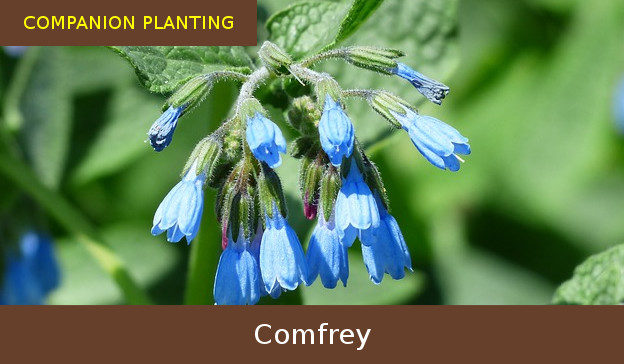Comfrey is nature’s wonder plant. It’s uses in the garden are legendary, so welcome to companion planting comfrey.
Companion Planting Comfrey
What is Comfrey?
Comfrey (Symphytum) is a herb with a deep tap root that can break through the deep soil and uptake minerals that other plants cannot reach.
Why Grow Comfrey?
As stated above comfrey reaches minerals in the soil that other plants can’t, so it is a good source of minerals to feed your plants.
Comfrey is a particularly valuable source of fertility to the organic gardener. It is very deep rooted and acts as a dynamic accumulator,[6] mining a host of nutrients from the soil. These are then made available through its fast-growing leaves (up to 1.8–2.3 kilograms (4.0–5.1 lb) per plant per cut) which, lacking fibres, quickly break down to a thick black liquid. There is also no risk of nitrogen robbery when comfrey is dug into the soil as the C:N ratio of the leaves is lower than that of well-rotted compost. Comfrey is an excellent source of potassium, an essential plant nutrient needed for flower, seed and fruit production. Its leaves contain 2–3 times more potassium than farmyard manure, mined from deep in the subsoil, tapping into reserves that would not normally be available to plants.[7]
What Comfrey Contains?
The main nutritious compounds in comfrey are:-
- Potash
- Nitrogen
- Phosphate
Any plant that roots, shoots or fruits will benefit from a weekly feed from comfrey tea and a mulch of comfrey leaves.
Lay comfrey leaves in the trench before sowing seed potatoes to prevent scabbing on the new potatoes.
Companion Planting Comfrey
Comfrey should ideally be grown as a stand alone plant as it grows quite large and can be invasive. That being said, growing comfrey close to your vegetables and allowing it to flower will attract many pollinating insects.
It has been proven to improve the condition of the soil just by growing. So if space is tight grow comfrey amongst your fruit trees.
Comfrey is a fast growing perrenial and if cared for properly the leaves can be harvested up to four times a season. Use the leaves as a fertiliser (comfrey tea) or as a mulch.
What to Use Comfrey For
Slugs and snails are attracted to comfrey so it makes a good sacrificial plant, grown amongst other susceptible plants.
As a fertiliser for tomatoes and other potash loving fruiting vegetables comfrey tea produces great results.
Used as a mulch comfrey leaves rot down incredibly fast which means your plants get the benefits quickly.
Because of the speed that comfrey leaves rot down they are ideal for adding a quick boost to compost bins.
Also known as “knitbone” in medievel times comfrey was used as a healing plant.
Comfrey was historically used to treat a wide variety of ailments ranging from bronchial problems, broken bones, sprains, arthritis, gastric and varicose ulcers, severe burns, acne and other skin conditions. It was reputed to have bone and teeth building properties in children, and have value in treating “many female disorders”.
There is wide spread consensus now that comfrey can cause liver problems or aggravate existing conditions. It is therefore not advisable to consume comfrey.
Which variety of Comfrey is Best to Grow?
Comfrey is a prolific flowering plant and the seeds germinate easily. To stop comfrey from over running your plot I would advise you to grow the Bocking 14 strain if possible. This is a sterile strain and will not spread by seed. (It can be spread successfully by root division).
When is the Best Time to Plant Comfrey?
The best time to plant comfrey is spring or autumn. Grow in reasonably fertile soil and plant at least 2 feet apart. Water well when planting and feed with a manure mulch once in a while. Comfrey beds can last up to 20 years.


US FDA has approved comfrey as a topical ointment. It is not recommended to eat comfrey (especially the inner small leaves – bigger ones are less poisonous). Check with your doctor before use.
Be careful where you plant it. It is almost impossible to get rid of once established. Confrey can be cultivated in tall large containers (perhaps a food grade 55 gallon drum with NO holes in the bottom – holes 6 inches above the bottom but on the sides can help). Remember, there is a limited supply of minerals in a container.
Comfrey can also used to boost milk production in farm animals by up to 4 times the normal amount. It is also used as an animal feed as well. Check with your Veterinarian.
It was used in the civil war to help heal injured soldiers.
Comfrey is in the Borage family (borage is an annual and a honey bee magnet).
Thanks for the comments crazy squirrel, My dad adds dried comfrey leaves to his tea and he is 83 but I personally don’t imbibe myself.Good point about the way it can take over if you’re not on top of it. I never knew comfrey was used as an animal feed. Thanks for taking the time to comment.